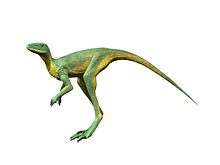Caseosaurus
Caseosaurus (/ˌkeɪziːoʊˈsɔːrəs/ KAY-zee-o-SAWR-əs) is a dubious genus of herrerasaurid theropod dinosaur that lived approximately 235 to 228 million years ago during the latter part of the Triassic Period in what is now Texas, in North America. Caseosaurus was a small, lightly-built, bipedal, ground-dwelling carnivore, that could grow up to 2 m (6.6 ft) long.
| Caseosaurus | |
|---|---|
 | |
| Holotype ilium in outer and inner view | |
| Scientific classification | |
| Kingdom: | Animalia |
| Phylum: | Chordata |
| Clade: | Dinosauria |
| Clade: | Saurischia |
| Family: | †Herrerasauridae |
| Genus: | †Caseosaurus Hunt et al., 1998 |
| Type species | |
| Caseosaurus crosbyensis Hunt et al., 1998 | |
Description
The genus Caseosaurus, is known from specimen UMMP 8870, an isolated hip bone that measures nearly 141 mm. A 3D model of this specimen is available on the University of Michigan Online Repository of Fossils. Size estimates suggest that Caseosaurus was at best 2 m (6.6 ft) long and weighed 50 kilograms (110.2 pounds) at most.[1]
Discovery
The genus name Caseosaurus, means "Case's lizard", and was named in the honor of the scientist who discovered it, Ermine Cowles Case. The Greek suffix "-saurus" (σαυρος) means "lizard".[2] The specific name crosbyensis, is a Latinized rendering of Crosby County in Texas, the site of its discovery. Caseosaurus was described and named by A. P. Hunt, Spencer G. Lucas, Andrew B. Heckert, Robert M. Sullivan and Martin Lockley in 1998 and the type species is Caseosaurus crosbyensis.[3]
Classification

In 1998, Hunt et al., examined UMMP 8870, a partial hip bone (ilium) that was assigned as a paratype of the dinosaur Chindesaurus and made it the holotype of a new dinosaur, Caseosaurus crosbyensis. Irmis et al. concluded that an ilium, NMMNH P-35995 originally assigned by Heckert et al., in 2000 to the dinosaur Eucoelophysis, strongly resembles the Caseosaurus holotype.[4] Langer (2004) examined the ilium and reassigned it back to the genus Chindesaurus.[5] Other paleontologists also agree that this may be the same dinosaur as Chindesaurus, which lived during the same period and geological region.
However, in 2018 Caseosaurus was considered a valid species, as a relative of Herrerasaurus outside of the Dinosauria.[6]
Distinguishing anatomical features
According to Hunt et al. (1998), Caseosaurus could be distinguished based on the following features:[3]
- a shallow brevis shelf is present on the ilium
- a medial longitudinal ridge that is more ventrally placed
- a transversely thinner postacetabular blade is present
Paleoecology
The only specimen of Caseosaurus was discovered in the Tecovas Formation of the Dockum Group in Texas, in sediments deposited during the Carnian stage of the Late Triassic period, approximately 235 to 228 million years ago. Caseosaurus's paleoenvironment included the archosaur Tecovasaurus and other early theropod dinosaurs, some of whom left bipedal tracks that were preserved.
External links
- Texas Dinosaurs from Texas A&M University
References
- "CASEOSAURUS". Dinochecker.com. Retrieved 2 July 2013.
- Liddell, Henry George and Robert Scott (1980). A Greek-English Lexicon (Abridged Edition). United Kingdom: Oxford University Press. ISBN 978-0-19-910207-5.
- Hunt, A. P., Lucas, S. G., Heckert, A. B., Sullivan, R. M., and Lockley, M. G., 1998, Late Triassic Dinosaurs from the Western United States: Geobios, v. 31, n. 4, p. 511-531.
- Irmis, Nesbitt, Padian, Smith, Turner, Woody and Downs, 2007. A Late Triassic dinosauromorph assemblage from New Mexico and the rise of dinosaurs. Science. 317, 358-361.
- Langer, 2004. Basal Saurischia. In Weishampel, Dodson and Osmolska. The Dinosauria Second Edition. University of California Press. 861 pp.
- Matthew G. Baron; Megan E. Williams (2018). "A re-evaluation of the enigmatic dinosauriform Caseosaurus crosbyensis from the Late Triassic of Texas, USA and its implications for early dinosaur evolution". Acta Palaeontologica Polonica. in press. doi:10.4202/app.00372.2017.









